New York Public Library Main Branch
|
New York Public Library Main Branch | |
|
| |
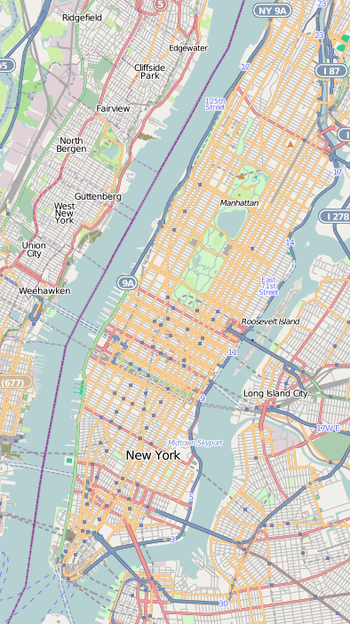 NY Public Library Main Branch  NY Public Library Main Branch  NY Public Library Main Branch | |
| Location | Fifth Avenue at 42nd Street, New York, NY |
|---|---|
| Coordinates | 40°45′12″N 73°58′56″W / 40.75333°N 73.98222°WCoordinates: 40°45′12″N 73°58′56″W / 40.75333°N 73.98222°W |
| Built | 1897–1911 |
| Architect | Carrère and Hastings |
| Architectural style | Beaux Arts |
| NRHP reference # | 66000546 |
| Significant dates | |
| Added to NRHP | October 15, 1966[1] |
| Designated NHL | December 21, 1965[2] |
| Designated NYCL | January 11, 1967[3] |
The Stephen A. Schwarzman Building of the New York Public Library, originally called the Central Building[4] and more widely known as the Main Branch or as the New York Public Library,[lower-alpha 1] is the flagship building in the New York Public Library system and a prominent historic landmark in Midtown Manhattan. The branch, opened in 1911, is one of four research libraries in the library system. It currently contains area of 646,680 square feet (60,079 m2)[5] and four stories open to the public. The main entrance steps are on Fifth Avenue opposite East 41st Street.
Rose Main Reading Room
The Library's famous Rose Main Reading Room (Room 315) is a majestic 78 by 297 feet (24 by 91 m), with 52-foot (16 m)-high ceilings. The room is lined with thousands of reference works on open shelves along the floor level and along the balcony, lit by massive windows and grand chandeliers, and furnished with sturdy wood tables, comfortable chairs, and brass lamps. It is also equipped with computers providing access to library collections and the Internet as well as docking facilities for laptops. Readers study books brought to them from the library's closed stacks. There are special rooms named for notable authors and scholars, many of whom have done important research and writing at the Library. But the Library has always been about more than scholars; during the Great Depression, many members of the general public, out of work, used the Library to improve their lot in life, as they still do.[6]
Selected divisions at the Main Branch
General Research Division
The General Research Division, located in the Deborah, Jonathan F. P., Samuel Priest, and Adam R. Rose Main Reading Room and Bill Blass Public Catalog Room, jointly serve as the gateway to the Library's research collections, which exceed 43 million items. The two rooms also serve as the central humanities and social sciences research hub of the Main Branch.
Closed stacks
The stacks within the Schartzman Building are a main feature of the building. Housed beneath the Rose Main Reading Room, the stacks have been described as a maze of steel laid bare that holds three and a half million volumes, which, if laid together, end to end, would measure over eighty miles.
Division of U.S. History, Local History, and Genealogy
The Irma and Paul Milstein Division of U.S. History, Local History and Genealogy, in 2008, acquired the holdings of New York Genealogical and Biographical Society. It houses one of the largest genealogical collections free and open to the public in North America, with an emphasis on New York City.
Map Division
The Lionel Pincus and Princess Firyal Map Division is one of the world’s premier map collections in terms of size, scope, unique holdings, diversity and intensity of use. Established in 1898, the holdings include more than 433,000 sheet maps and 20,000 books and atlases published between the 16th and 21st centuries. The collections range from the global to the local scale and support the learning and research needs of a wide variety of users.
Manuscripts and Archives Division
The Manuscripts and Archives Division holds over 29,000 linear feet of manuscripts and archives in over 5,500 collections.
Other divisions at the Main Branch
- Dorot Jewish Division
- Henry W. and Albert A. Berg Collection of English and American Literature
- Carl H. Pforzheimer Collection of Shelley and His Circle
- Rare Book Division
- Miriam and Ira D. Wallach Division of Art, Prints and Photographs
Facility
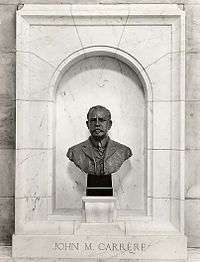
Marble on the library building is about three feet thick, and the building is Vermont marble and brick all the way through. The exterior is 20,000 blocks of stone, each one numbered in preparation for a renovation announced in 2007. It stretches 390 feet along Fifth Avenue.[7]
Two stone lions (made of Tennessee marble) lie at either side of the stairway to the entrance. The famous pair guarding the entrance were sculpted by Edward Clark Potter. Their original names, "Leo Astor" and "Leo Lenox" (in honor of the library's founders) were transformed into Lord Astor and Lady Lenox (although both lions are male), and in the 1930s they were nicknamed "Patience" and "Fortitude" by Mayor Fiorello La Guardia, who chose the names because he felt that the citizens of New York would need to possess these qualities to see themselves through the Great Depression. Patience is on the south side (the left as one faces the main entrance) and Fortitude on the north.[6]
Before the end pavilions are flagpoles, whose sculpted bronze bases designed by Thomas Hastings in 1912 were realized by the sculptor Raffaele Menconi, who often worked closely with New York architects of the Beaux-Arts generation and had a deft command of the 16th-century Italian Mannerist classical idiom that was required by Hasting's design. The bronzes were cast at Tiffany Studios in Long Island City. They were rededicated to New York's former Reform mayor, John Purroy Mitchell.
Facility history
Construction
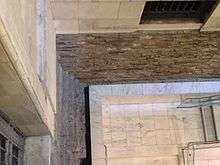
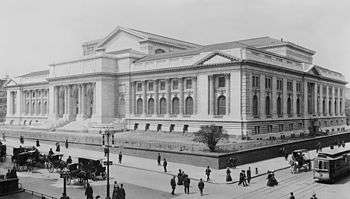
The consolidation of several libraries into the New York Public Library in 1901, along with the large Tilden bequest and a donation of $5.2 million from Andrew Carnegie,[10] allowed for the creation of an enormous library system befitting the nation's largest city. However, the founders also wanted an imposing main branch.
A prominent, central site for it was available at the two-block section of Fifth Avenue between 40th and 42nd Streets, then occupied by the Croton Reservoir, which was obsolete and no longer needed (traces of the old reservoir still exist on the library floor). [9] Dr. John Shaw Billings, who was named the first director of the New York Public Library, recognized the viability of the location for his envisioned structure. His design for the new library formed the basis of the landmark building that became the central Research Library (now known as the Humanities and Social Science Library) on Fifth Avenue.[6]
Billings's plan called for a massive reading room on top of seven floors of book-stacks, combined with the fastest system for getting books into the hands of those who requested to read them. Following a competition among the city's most famous architects, the relatively unknown firm of Carrère and Hastings was selected to design and construct the new library. The result, regarded as the apex of Beaux-Arts design, was the largest marble structure up to that time in the United States. The cornerstone was laid in May 1902.[6]
Work progressed very gradually on the library, which ultimately cost $9 million to build. During the summer of 1905, giant columns were put into place and work on the roof was begun. By the end of 1906, the roof was finished and the designers commenced five years of interior work. In 1910, 75 miles (121 kilometres) worth of shelves were installed to hold the collections that were designated for being housed there, with substantial room left for future acquisitions. It would take an entire year to transfer and install the books which theretofore had been located in the Astor and Lenox libraries.[6]
Opening

On May 23, 1911, the main branch of the New York Public Library was officially opened. The ceremony was presided over by President William Howard Taft and was attended by Governor John Alden Dix and Mayor William Jay Gaynor.[6]
The following day, May 24, the public was invited. The response was sensational. Tens of thousands thronged to the Library's "jewel in the crown." The opening day collection consisted of more than 1,000,000 volumes. The New York Public Library instantly became one of the nation's largest libraries and a vital part of the intellectual life of America. True to Dr. Billings' plan, library records for that day show that one of the very first items called for was N. I. Grot's Nravstvennye idealy nashego vremeni ("Ethical Ideas of Our Time") a study of Friedrich Nietzsche and Leo Tolstoy. The reader filed his slip at 9:08 a.m. and received his book six minutes later.[6]
Growth and renovation
Dr. Harry Miller Lydenberg served as director between 1934–1941.[11]
Over the decades, the research collection grew until, by the 1970s, it was clear that the collection would eventually outgrow the existing structure. Thus, it was decided to expand the library by burrowing under the west side of Bryant Park. In the 1980s the central research library added more than 125,000 square feet (11,600 m2) of space and several miles of bookshelf space to its already vast storage capacity to make room for future acquisitions. This expansion required a major construction project in which Bryant Park, directly west of the library, was closed to the public and excavated. The new library facilities were built below ground level. The park was then restored on top of the underground facilities and re-opened to the public.
In the three decades before 2007, the building's interior was gradually renovated. In December 2005, the Lionel Pincus and Princess Firyal Map Division space, with richly carved wood, marble, and metalwork, was restored.[7]
On December 20, 2007, the library announced that it would undertake a three-year, $50 million renovation of the building exterior, which had suffered damage from weathering and automobile exhaust. The Vermont marble structure and the sculpture elements on it were to be cleaned, 3,000 cracks were to be repaired, and restoration work would also be done on the roof, stairs, and plazas. All of the work was scheduled to be completed by the centennial in 2011.[12] New York Mayor Michael R. Bloomberg, on behalf of the library, asked the mayor of Paris to lend to New York the services of François Jousse, the city engineer responsible for lighting Paris' monuments, structures and official buildings. Library director Paul LeClerc said in 2007 that “my ambition is for this to be the building you simply must see in New York at nighttime because it is so beautiful and it is so important.”[7]
As of 2004, streaks were already blackening the white marble and pollution and moisture were corroding the ornamental statuary, causing architectural details to erode, including the edges of cornices and features on carved faces. “Tiny particles of rubber scattered by passing car tires have accumulated on the building, mixing gradually with water to turn the marble into gypsum, which causes the outer layer to crumble in a sugaring effect,” according to an article in The New York Times.[7]
By late 2007, library officials had not yet decided whether to try to restore damaged sculptural elements or just clean and "stabilize" them. Cleaning would be done either with lasers or by applying poultices and peeling them off.[7]
In 2008, the library announced that the main branch building would be renamed in honor of Stephen A. Schwarzman, in recognition of his unconditional donation of $100 million toward the renovation and expansion of the building.[13]
In late 2012, a Central Library Plan was announced, in which two nearby branches would be closed and their activities merged into the main building.[14] The plan was abandoned in May 2014.[15]
In May 2014, one of the "gilded-plaster rosettes" in the ceiling of the Rose Main Reading Room fell to the floor 50 feet below.[16] The NYPL closed the Rose Main Reading Room and the Bill Blass Public Catalog Room for renovations. The $12 million restoration project included “recreating and replacing the rosette that fell, reinforcing each rosette with steel cables, and installing LED lighting.”[17] The NYPL commissioned EverGreene Architectural Arts to recreate the mural in the Bill Blass Public Catalog Room, which had “suffered irreparable discoloration, overpainting and water damage” during its 105-year history.[18] The NYPL also installed a $2.6 million book delivery system, using a conveyor belt and 24 book carts that could each carry up to 30 pounds (14 kilograms) through the library's eleven levels.[19] The restored Rose Main Reading Room and Bill Blass Public Catalog Room reopened October 5, 2016.[20]
Beginning in August 2017, the Main Branch is temporarily hosting an interim branch library at 42nd Street.[21] The interim library holds part of the collection of the NYPL Mid-Manhattan Branch, ordinarily located across the street at Fifth Avenue and 40th Street, while the Mid-Manhattan Branch is closed for renovation scheduled to be completed in 2020.[22] The Mid-Manhattan Branch's collection of pictures have also been temporarily relocated to the Main Branch.[23]
National Historic Landmark
The Main Branch building was declared a National Historic Landmark in 1965,[2] listed on the National Register of Historic Places in 1966,[1] and designated a New York City Landmark in 1967.[3] It was renamed in 2008 after businessman Stephen A. Schwarzman, who donated a large sum of money for the refurbishment of the building.
Library Way
Leading up to the Main Branch, on 41st Street between Park and Fifth Avenues, is a series of plaques known as Library Way. Library Way comprises a series of illustrated bronze sidewalk plaques featuring quotes from famous authors, poets, and other notables. It features 48 unique plaques in all, duplicated (to thus total 96 plaques) embedded along the north and the south sides of 41st Street[24] The Wall Street Journal reports: "The quotes were selected during the 1990s by a panel that included representatives from the library; the Grand Central Partnership, which manages the Grand Central Business Improvement District; and the New Yorker magazine. And the plaques, which are graphically intriguing in their own right, were designed by Gregg LeFevre."[25][26] Brochures are available at the Friends of the Library counter on the first floor of the New York Public Library (41st Street and Fifth Avenue).[27] [28]
Library Way is one block north of the Mid-Manhattan Library, located at 455 Fifth Avenue (at 40th Street). Granite plaques have also been placed in the sidewalks of lower Broadway in honor of ticker-tape parades held there in the past. In the garment district from 39th to 41st Street on Broadway, plaques commemorate fashion designers including Ralph Lauren, Calvin Klein and Geoffrey Beene.[29]
In popular culture
The Main Branch has been used as a setting for scenes in several cinema and television productions and has also been referenced and illustrated in other artistic, literary, and cultural works.
Cinema
The NYPL Main Branch was featured in the 1978 film The Wiz[30] when Dorothy and Toto stumble across it, one of its lions comes to life, and joins them on their journey out of Oz. It was a major location in the 2004 apocalyptic science fiction film The Day After Tomorrow.[30] It is also featured prominently in the 1984 film Ghostbusters, when a librarian in the basement reports seeing a ghost which becomes violent when approached.[31] Additionally, the building is featured as a wedding venue in the 2008 film Sex and the City. It was also prominently featured in the 2011 film The Adjustment Bureau. Frederick Wiseman's 2017 documentary, Ex Libris: The New York Public Library, is about the entire library system, but prominently features the Main Branch.
Other films in which the library appears include:
- 42nd Street (1933)
- Portrait of Jennie (1948)
- Pickup on South Street (1953)
- Breakfast at Tiffany's (1961)
- Two for the Seesaw (1962)
- You're a Big Boy Now (1966)
- A Boy Named Charlie Brown (1969)
- Beneath the Planet of the Apes (1970)
- The Possession of Joel Delaney (1972)
- Network (1976)
- Chapter Two (1979)
- Escape from New York (1981)
- Regarding Henry (1991)
- Picture Perfect (1997)
- The Thomas Crown Affair (1999)
- Head over Heels (2001)
- The Time Machine (2002)
- Spider-Man (2002)[30]
- Shortcut to Happiness (2004)
- Uncertainty (2008)
- Arthur (2011)
- We'll Take Manhattan (2012)
- 13 Going on 30 (2014)
- Winter's Tale (2014)[32]
Television
In television, the NYPL Main Branch was featured in "The Library" episode of Seinfeld, in which Cosmo Kramer dates a librarian there, Jerry Seinfeld is accosted by a library cop named Mr. Bookman for late fees, and George Costanza encounters his high school gym teacher living homeless on its stairs. It is the setting for much of "The Persistence of Memory," the eleventh part of Carl Sagan's Cosmos TV series.
Literature
The Library also appears in literature. Lynne Sharon Schwartz's Writing on the Wall (2005) features a language researcher at NYPL who grapples with her past following the September 11 attacks. Cynthia Ozick's novel Heir to the Glimmering World (2004) set just prior to World War II, involves a scholar who has fled from Nazi Germany researching the Karaite Jews at NYPL. Matthew Reilly's novel Contest (1996) sets an intergalactic gladiatorial fight in the NYPL, resulting in the building's total destruction.
Lawrence Blochman's Death Walks in Marble Halls (1942) features a murder committed using a brass spindle from a catalog drawer. Jane Smiley's Duplicate Keys (1984), also a murder mystery, featured an NYPL librarian who stumbles upon two bodies of people who died in 1930. Allen Kurzweil's novel The Grand Complication (2001) is the story of an NYPL librarian whose research skills are put to work finding a missing museum object.
Several poems involve the Library, including E. B. White's "A Library Lion Speaks" and "Reading Room" in Poems and Sketches of E.B. White (1981); Richard Eberhart's "Reading Room, The New York Public Library," in Collected Poems, 1930-1986 (1988); and Lawrence Ferlinghetti's "Library Scene, Manhattan," in How to Paint Sunlight (2001). Excerpts from several of the many memoirs and essays mentioning the New York Public Library are included in the anthology Reading Rooms (1991), including reminiscences by Alfred Kazin, Henry Miller, and Kate Simon.
The New York Public Library has also been heavily mentioned in the 6th and final book in Chris Colfer's "The Land of Stories" series, Worlds Collide, as the Rose Main Reading Room is where the doorway between realms appears.
See also
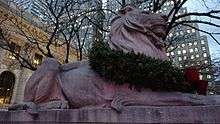
Notes and references
Notes
- ↑ As the flagship building of the New York Public Library system, the Main Branch is often seen as an icon of the entire New York Public Library, so it is referred to as such.
Inline references
- 1 2 National Park Service (2007-01-23). "National Register Information System". National Register of Historic Places. National Park Service.
- 1 2 "New York Public Library". National Historic Landmark summary listing. National Park Service. 2007-09-16. Archived from the original on 2007-12-05.
- 1 2 "New York Public Library" (PDF). New York City Landmarks Preservation Commission. January 11, 1967. Retrieved 24 June 2016.
- ↑ Handbook of the New York Public Library. 1921. p. 7. Retrieved 10 January 2016.
The Central Building of The New York Public Library
- ↑ "Fun Facts about the Library". Find the Future, NYPL at 100. The New York Public Library. Retrieved 25 May 2015.
- 1 2 3 4 5 6 7 History at the Wayback Machine (archive index)
- 1 2 3 4 5 Pogrebin, Robin, "A Centennial Face-Lift For a Beaux-Arts Gem: Restoration of Library Facade Begins With Visions of a Nightly Sectacle", article, The New York Times, page B1, December 20, 2007
- ↑ Henry Hope Reed. The Golden City (New York: Norton Library) 1971, illustrated p. 38.
- 1 2 "Croton Aqueduct Remnants". Forgotten NY. Retrieved 10 June 2014.
- ↑ "CITY WILL ACCEPT MR. CARNEGIE'S LIBRARIES; Formal Action by the Board of Estimate to Be Taken To-morrow". The New York Times. 1901-03-17. ISSN 0362-4331. Retrieved 2017-07-25.
- ↑ Dain, Phyllis (October 1977). "Harry M. Lydenberg and American Library Resources: A Study in Modern Library Leadership". The Library Quarterly. 47 (4): 451–469. doi:10.1086/620725. JSTOR 4306860.
- ↑ Username or bar code:. "|". Nypl.org. Retrieved 2014-08-07.
- ↑ "After Schwarzman's Big Gift, a New Name for the Library". DealBook. The New York Times. April 23, 2008. Retrieved 2017-07-25.
- ↑ Central Library Plan NYPL press release
- ↑ Stacks to Stay by Barbara Ross and Corky Siemaszko, NY Daily News, 2014 May 7
- ↑ Maloney, Carey. "The New York Public Library's Beloved Rose Main Reading Room to Reopen Wednesday | Architectural Digest". Retrieved 2016-10-04.
- ↑ Alessio, Devin (2016-09-13). "New York Public Library Will Reopen Gorgeous Rose Reading Room". Elle Decor. Retrieved 2016-10-04.
- ↑ Ilnytzky, Ula (2016-04-08). "NY Public Library Installs Recreation of Century-Old Mural". NBC New York. Retrieved 2016-10-04.
- ↑ Lucader, Rob (2016-09-22). "New York's iconic public library just installed a $2.6 million 'book train'". Business Insider. Retrieved 2016-10-04.
- ↑ "Rose Main Reading Room Ceiling Restoration". The New York Public Library. Retrieved 2016-10-04.
- ↑ "NYPL to close Mid-Manhattan Library for $200M, 3-year renovation in August". New York's PIX11 / WPIX-TV. 2017-06-29. Retrieved 2017-07-07.
- ↑ Davidson, Justin. "The Mid-Manhattan Library Might Get Better!". Daily Intelligencer. Retrieved 2017-07-07.
- ↑ "Mid-Manhattan Library to Close 2 Years for $200M Renovation". DNAinfo New York. 2016-11-07. Archived from the original on 2017-11-09. Retrieved 2017-07-07.
- ↑ Bevan, Lily (October 25, 2010). "Get Thee to a Library! Unsung Hero of 41st St: Library Way". The Huffington Post.
- ↑ Gardner, Ralph Jr. (September 17, 2014). "Urban Gardner: The Great Library Way (Library Way Celebrates Its 10th Anniversary)". The Wall Street Journal.
- ↑ Lampasone, Lauren (Reference and Research Services) (September 13, 2013). "Library Way". NYPL Blog.
- ↑ Riedel, Mija Riedel (October 28, 2005). "The Words on the Street (Walks of art: Stroll down New York's sidewalks and over famous words". The Washington Post.
- ↑ "Library Way". Grand Central Partnership.
- ↑ Haberman, Clyde (October 14, 2005). "NYC; What Lies Underfoot". The New York Times.
- 1 2 3 Pop Culture Places: An Encyclopedia of Places in American Popular Culture, by Gladys L Knight, California Greenwood, an imprint of ABC-CLIO, LLC (2014), p. 670
- ↑ Making Ghostbusters: The Screenplay, Don Shay (ed.), New York Zoetrope (1985), pps. 16, 23, 24; OCLC 982190508; ISBN 0-918432-68-5
- ↑ "Most Popular Film Locations: New York Public Library," Mark Rogers (ed.), otsony
.com (On the Set of New York) (retrieved June 25, 2018)
General references
- Robin Pogrebin (23 October 2008). "British Architect to Redesign City Library". New York Times.
- Nicolai Ouroussoff (23 October 2008). "Treading Carefully but Not Timidly in a Civic Masterpiece". New York Times.
- Scott Sherman (19 December 2011). "Upheaval at the New York Public Library". The Nation.
- Norman Oder (22 December 2011). "'Upheaval at the New York Public Library'? At the Least, Some Clouds Over Transformation Plan". Library Journal website.
- Robin Pogrebin (16 February 2012). "Ambitions Rekindled at Public Library". New York Times.
- "Controversy at the New York Public Library". The Leonard Lopate Show. WNYC. 12 March 2012. Archived from the original on 14 April 2012.
- Caleb Crain (15 March 2012). "Build More Deliberately". Steamboats Are Ruining Everything.
- Scott McLemee (28 March 2012). "Stop Cultural Vandalism". Inside Higher Ed.
- Anthony Grafton (2 April 2012). "A Tale of Two Libraries and a Revolution". The Daily Princetonian.
- Christopher Shea (4 April 2012). "The Changing Culture of the New York Public Library". Ideas Market, a blog of the Wall Street Journal.
- Brian Braiker (6 April 2012). "New York Public Library's plan to take books off shelves worries scholars". The Guardian.
- Garrison Keillor and the staff of A Prairie Home Companion (7 April 2012). "Guy Noir Visits the New York Public Library". A Prairie Home Companion.
- Jennifer Maloney (9 April 2012). "Libraries Rethink Their Role in City". Wall Street Journal.
- "New York Public Library President Anthony Marx". The Leonard Lopate Show. WNYC. 10 April 2012. Archived from the original on 13 May 2012.
- Robin Pogrebin (15 April 2012). "Library Chief Defends Plan to Renovate". New York Times.
- Francine Fialkoff (16 April 2012). "Rich NYPL, Poor NYPL". Library Journal.
- Victoria Bekiempis (16 April 2012). "New York Public Library Renovations: Good or Bad?". Runnin' Scared: A Village Voice News Blog.
- Scott Sherman (18 April 2012). "The Battle Over the New York Public Library, Continued". The Nation.
- "Anthony Marx, New York Public Library President, Answers Reader Questions". Arts Beat blog, New York Times. 20 April 2012.
- Edmund Morris (22 April 2012). "Sacking a Palace of Culture". New York Times.
- Jennifer Howard (22 April 2012). "Debate at N.Y. Public Library Raises Question: Can Off-Site Storage Work for Researchers?". Chronicle of Higher Education.
- Chloe Schama (27 April 2012). "Let in the Riffraff: In Praise of the New York Public Library's Renovation Plan". The New Republic.
- Charles Petersen (May 2012). "Lions in Winter". n+1. Brooklyn, NY.
- Robert Darnton (7 June 2012). "In Defense of the New York Public Library". New York Review of Books.
- G. Bellafante (June 8, 2012). "Shh! Scholars Fight Over Library Plan". New York Times.
- David A. Bell (August 2, 2012). "The Bookless Library". The New Republic.
- Robin Pogrebin (January 9, 2013). "Debate Continues Over Public Library Plan". New York Times.
External links
| Wikimedia Commons has media related to Schwarzman Building of the New York Public Library. |


